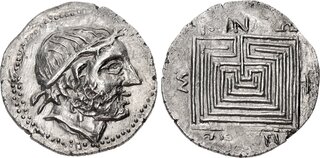| Classical Numismatic Group > Triton XXVII | Auction date: 9 January 2024 |
| Lot number: 204 Price realized: 55,000 USD (Approx. 50,375 EUR) Note: Prices do not include buyer's fees. | Show similar lots on CoinArchives Find similar lots in upcoming auctions on |
| Lot description: CRETE, Knossos. Mid 2nd-early 1st centuries BC. AR Tetradrachm (32mm, 15.67 g, 12h). Diademed and bearded head (of Minos?) right / Labyrinth; KNΩ/Σ-I/ΩN in three lines across field. Cf. Svoronos, Numismatique 98–101 and 177–8 (for type). Some cleaning marks and pitting. EF. An unpublished issue, struck between Svoronos types 98 and 177. The ancient city of Knossos, the remains of which were excavated by Sir Arthur Evans, beginning in 1900, was founded in the Minoan Period (circa 1700-1400 BC) as a large and complex palace-city. Although the exact origin of the word labyrinth, as well as its location, remains open to scholarly conjecture, the intricate maze of rooms and interior courtyards of this palace-city contributed to the later Greek use of the word to describe a maze and the source of the events connected with it to Crete. According to the Greek myth, Minos was the first king of Crete. Although he gave the island its first constitution, ordered the construction of the palace at Knossos, and was the first to build a navy, he was a cruel tyrant and imperialist. One of his subject cities was Athens. He demanded from its citizens as payment every nine years seven youths and seven virgins. Minos would feed them then to the Minotaur, a half-man, half-bull who was held in the Labyrinth, a large walled maze. To stop this brutal tribute, the Athenian hero Theseus had himself sent as part of the required tribute. With the assistance of Ariadne, the daughter of Minos, Theseus was able to navigate the Labyrinth successfully and kill the Minotaur. Estimate: 10000 USD |  |



